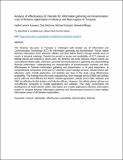| dc.description.abstract | The fisheries sub-sector in Tanzania is challenged with limited use of Information and Communication Technology (ICT) for information gathering and dissemination. Fishers obtain fisheries information from extension officers and their fellow fishers through mainly word of mouth in physical meetings. Despite the growth in access and availability of ICT channels on Mobile phones and Internet in recent years, the fisheries sub-sector decision-makers mainly use conventional media (radio, television, personal communications) in gathering and disseminating fisheries information. Understanding the characteristics of communication channels and their effectiveness in fisheries information gathering and dissemination is of great importance. A comprehensive comparison of the six ICT channels (short message services, cellular phone call, television, radio, mobile application, and website) was done in this study using effectiveness probability. The findings from this study indicated that, short message service (SMS) and cellular phone calls are most effective for fishers. Mobile application, cellular phone calls, websites, and SMS are effective for fish traders and fisheries officers. However, the cellular phone call was not cost-effective compared to mobile applications and websites. This study recommends the development of multi-channel (SMS, web-based, and mobile application) fisheries information system to enhance fisheries information gathering and dissemination process to meet realistic information needs of all fisheries stakeholders. | en_US |

